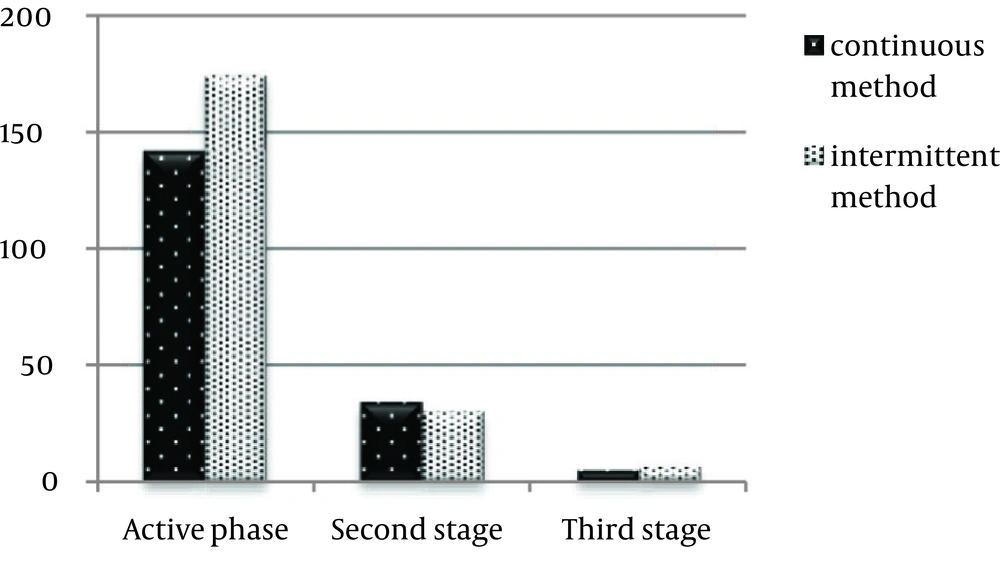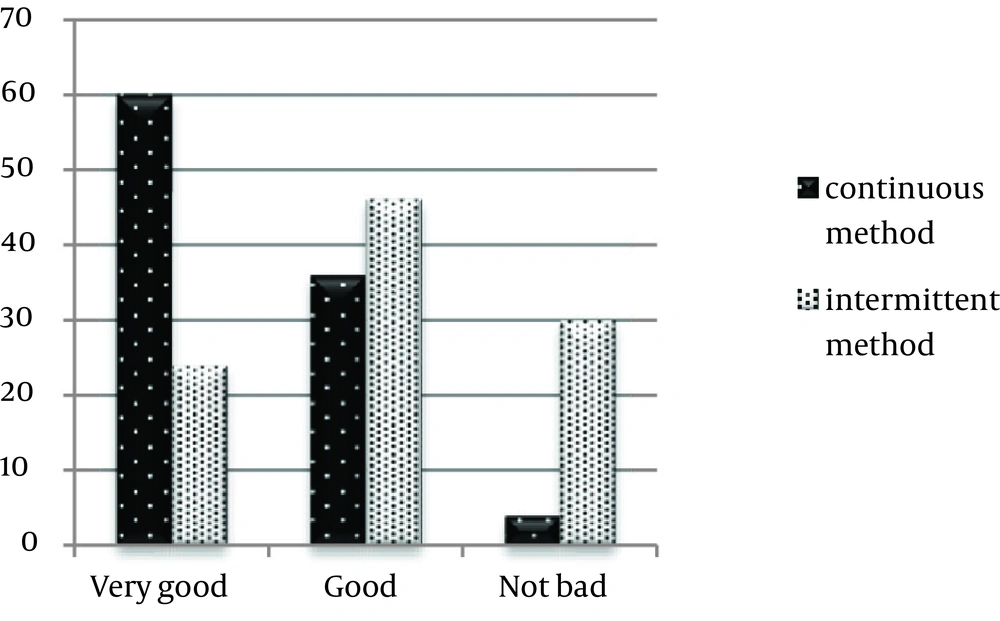1. Background
Delivery is one of the most painful phenomenons in life and human has tried to find a way to alley labor pain at all times. Severe pain that arouses maternal anxiety leads to releasing catecholamines that in turn can cause prolonged labor and dystocia. Prolongation of labor can cause fetal complications like head compression, oxygenation disturbance, low Apgar and finally fetal death. Also, prolonged labor increases maternal morbidity and mortality due to exhaustion of mother, postpartum hemorrhage and even uterine rupture. Various methods are applied for pain relief of labor such as injectable opioids, regional anesthesia and inhalational analgesics [1]. Simpson was the first one that experienced gas inhalation “ether” for women during labor pain in 1847. Years later, Snow applied chloroform for Queen Victoria during her eighth delivery [1]. The gas applying now is a mixture containing 50% of N2O and 50% of O2 which was introduced for pain relief of labor in England, in 1961, named entonox [2]. Entonox (N2O2) is easily used through a facemask, individually. One of the mechanisms of its action is through releasing endogen opioids, and the other one is by stimulation of gamma-aminobutiric acid receptors in brain that leads to an anti-anxiety and euphoric effect [2].
Numerous studies have demonstrated that entonox is safe for both mother and fetus and has an acceptable efficacy on decreasing labor pain [2, 3]. Entonox can be used in two manners during labor, intermittently and continuously. In the intermittent method, the mother breathes in mask only during uterine contractions and lays it aside as soon as termination of pain; whereas, in continuous method she keeps using the mask during active phase of labor [2]. Technically speaking, it takes at least 30 seconds for gas to be mixed with blood. So the mother should apply the mask at least 30 seconds before beginning of contraction. But usually the mother breathes synchronically with feeling the pain which leads to not receiving desirable painless effect. On the contrary, it seems that continuously use of entonox is easier and more efficacious for pain relief. It is customary to use entonox intermittently. Although there have not been enough indicated clinical trials about the comparison of the two methods, most of maternity care staff is afraid of obstetrical complications by continuous method [2, 4, 5]. Zare Tazarjani et al. showed continuous method shortens first stage of labor in comparison with the mothers that did not use entonox [6].
2. Objectives
As entonox is used in numerous centers intermittently and it seems that continuous method has benefits such as more analgesic effect and easier usage, we decided to compare the effects of two methods on labor progress.
3. Patients and Methods
This randomized controlled clinical trial was conducted in Sabzevar Mobini Hospital in 2013. After the approval of the ethics committee of Sabzevar University of Medical Sciences (medsab.rec.92.28) and obtaining the informed consent of patients, a total of 100 women admitted for vaginal delivery, were enrolled in the study. This number of sampling was determined by confidence coefficient of 95% and power of 80%. The participants were divided into two groups, group A including 50 women received entonox intermittently and group B containing 50 women used it continuously. Selection of patients was through simple choosing and they were settled in two groups by accidental allocation. The inclusion criteria were singleton pregnancy, cephalic presentation and term gestation. The exclusion criteria were macrosomia, contracted pelvis of mother, repeated cesarean section, unconfident fetal heart rate and contraindications of entonox usage including head injury, severe asthma, inability, and unwillingness of patients to use entonox. Before participating in the study, a comprehensive interview was conducted with mothers and registered in the checklist.
Training of mothers was done by a midwife (sampler). In group A, mothers were breathing in mask during uterine contractions and put it aside between them. In group B mothers were using entonox constantly. The gas inhalation was performed by commencement of active phase (dilatation 3 - 4 cm, and effacement 40 - 50%) and terminated by full dilatation of cervix. Labor progression was drawn on partograph and contraction duration and FHR were evaluated and registered, respectively. After simple random allocation and collecting data, information was analyzed by SPPS-17 software, t-test and χ2 and P < 0.05 was considered statistically significant.
4. Results
The findings showed that demographic data, obstetric and fetal characteristics were matched in two groups. Meantime of active phase of labor was 142 minutes in continuous method and 172 minutes in intermittent group with no significant difference between them (Figure 1). Meantime of second stage of labor had no significant difference between two groups (Figure 1). Meantime of third stage of labor had no significant difference between two groups. Continuous method did not protract labor. Fischer test illustrated that two groups were not different significantly in terms of prolonged labor. Also continuous method had no adverse effect on uterine contractility, the necessity for augmentation had no significant difference between two groups. The study showed that satisfaction rate was significantly more in continuous method compared with intermittent method (P < 0.0001) (Figure 2). Infants, outcome was acceptable in both methods.
5. Discussion
Entonox which is a well-known analgesic agent can be used in two methods. Although the intermittent method has been commonly used since 1961 (the first commercial introduction of entonox), we found continuous method is also efficacious and harmless. In our experience, continuous method had no adverse effects on labor progression and interestingly, was accompanied by more satisfaction rate. Entonox is a commonly used agent for relieving labor pain because of an acceptable efficacy, using easily and safety for both mother and fetus [2, 3, 6]. Also entonox is described as none-inflammable, odorless, colorless, tasteless and short-acting [7]. The gas is filtrated in the lungs totally, so it is even utilizable in hepatic and renal diseases [2]. Fortunately its minimal side effects like dizziness are resolved several minutes after removal of mask [2-5]. Our results showed the duration of active phase had no significant difference in two groups and it was even shorter in continuous method (142 minutes) compared with intermittent method (172 minutes). Creasy mentioned mean duration of active phase about 3.5 hours without using entonox [8]. In our study this time was 2.9 hours in intermittent group and 2.3 hours in continuous method. We believe the reason for this decrease may be diminished catecholamines. It is said that aggravation of pain and anxiety during labor has negative impaction on labor progression due to releasing catecholamines. Numerous surveys have compared labor progress in entonox users with nonusers. Pita et al. [9] reported 120 minutes, and Agah [10] reported 232 minutes in entonox users in active phase labor by intermittent method. Salahian et al. [11] and Iravani [12] found no difference in labor duration with intermittent entonox utilization. Rezayi et al. [13] and Jaffari et al. [14] reported that labor duration is shorter by intermittent users significantly. Zare Tazarjani et al. showed that continuous gas usage shortens first stage of labor but does not change the second stage duration of labor [6]. In short, in our study both methods shortened the duration of labor compared with the situation that the parturients do not use entonox. It is in agreement with Zare Tazarjani et al. [6], Pita et al. [9] and Jaffari et al. [14] but it is inconsistent with Agah [10], Salahian et al. [11] and Iravani [12]. In this study, the continuous method even shortened this duration more than the intermittent method. In our observation the mothers had less anxiety with continuous method; this relaxation was the superior advantage which lowered labor duration. In our study, mothers’ satisfaction rate was (96%) in continuous method and (70%) in intermittent method which was similar to results of Arthurs and Rosen, in 1981 they showed that continuous method had better acceptance and 96% of mothers wished to continue offering the continuous method [15].
It seems that many women are willing to use entonox continuously because they become anxious between contractions about their next pain in intermittent method. On the other hand, maternity care staff reminds mothers constantly to put the mask aside by pain termination because of the fear of obstetric complications which in turn increases mother’s anxiety. Also its application is easier and probably associated with more painless effect than intermittent method. To put it in a nutshell, in our study, using entonox continuously had no adverse effects on labor length and even shortened it compared with intermittent method. This study showed that continuous method had no adverse effects on labor outcomes and the participants of continuous group declared clearly more satisfaction compared with intermittent group. In conclusion, according to this study, continuous use of entonox is as safe as intermittent method. In our experience the mothers were more satisfied by continuous method as well. We believe by further investigations, health staff can set mothers free to choose the desired method of entonox usage. As a rule, this action can influence health promotion of mother, baby and midwives both physically and psychologically and midwives both physically and psychologically.

